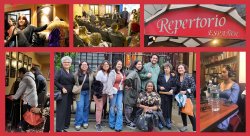Montclair Students Continue to Advocate for Accessibility
Posted in: CHSS News, CHSS Newsletter, Homepage News and Events, Spanish and Latino Studies

La dama boba, an iconic play written by Lope de Vega during Spain’s Golden Age, was recently audio-described by students in the Spanish and Latino Studies Department at Repertorio Español.
Live Audio Description is the process in which audience members listen through an earphone and special receiver to a narration that describes the relevant visual elements of a performance without intruding on the dialogue of the performers. This narrator is usually somewhere in the theater watching the play through a live feed. It is a process that makes live performance accessible to those with visual impairments.
What separates this project from other live audio descriptions is that it is specifically designed for the visually impaired Spanish speaking community within New Jersey and New York.
This is the fourth year that the Department has partnered with Repertorio Español and Resident Director Leyma López. The relationship has been led by Dr. María José García Vizcaíno, the current Chair and Associate Professor of the Department. García-Vizcaíno is a trailblazer, being the first professor to offer a course in Spanish Audio Description (SPAN429), not only here at Montclair State but across all universities within the United States.
The process of audio-describing La dama boba took the students three and a half months to complete. They began by dividing the script and each writing their own audio descriptions, then meeting weekly as a group to provide feedback and rehearse their script. For this play, this year the team benefited from the expertise of Dr. Galoppe, MSU professor whose area of research is precisely Spanish Golden Age theater. Thanks to his collaboration and involvement on this project, students were more conversant with 17th century terminology and contextual information necessary for the audio description.
There is also a unique feature that these students provide – a pre-show tactile experience. While hearing the described performance is important, it is also crucial to feel key elements of the production itself.
This year, the students created a miniature version of the stage, including a teaching map that one of the characters uses. This map had letters, and the students provided two versions, one with foam letters and the other in braille. They also provided a 17th-century-styled costume dress that included a ruffled collar, corset, hoop skirt, and intricate fabric, helping audience members envision the costumes of the play.
It is a very unique experience that we hope to continue. We hope to be able to provide audio description for more theaters across New Jersey and further advance accessibility.
– García-Vizcaíno
